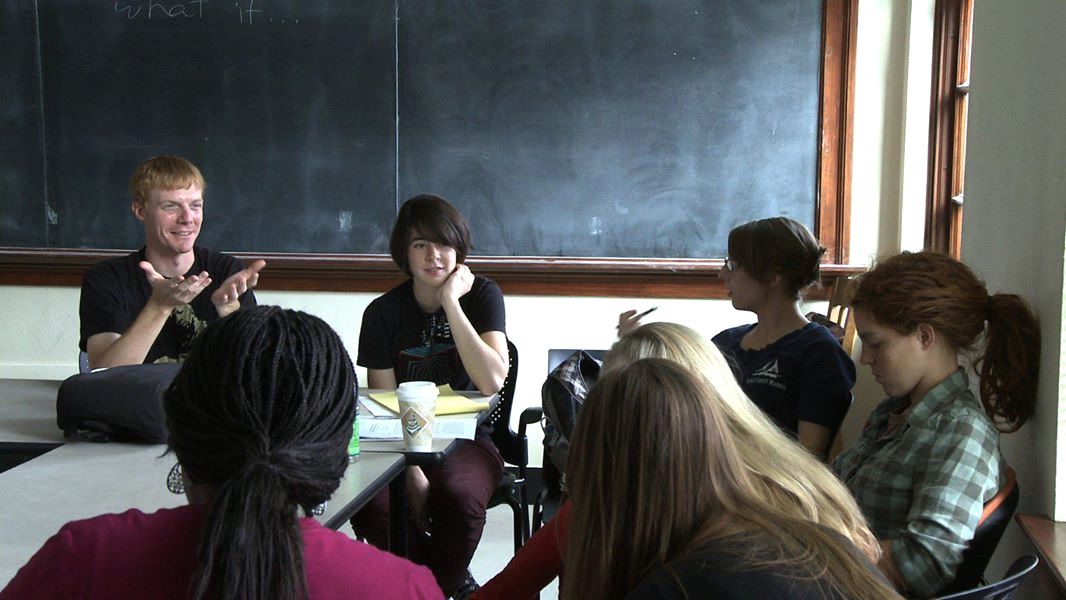Meanings are malleable. Words bend and break under the stress of unintended use, abuse, or overuse. Like machine parts pushed past their limits, cogs stripped bare of their teeth, the language we use wears out, weakening the culture that carries it and our knowledge thereof.

Aldous Huxley (1970) writes, “In the days before machinery men and women who wanted to amuse themselves were compelled, in their humble way, to be artists. Now they sit still and permit professionals to entertain them by the aid of machinery” (p. 11). We use metaphors and metonymies of the machine to explain everything from individual bodies and brains to society and the cosmos (see Lakoff, 1993; Raunig, 2010; Wilden, 1972). Aristotle used many anthropomorphic ideas to describe natural occurrences, but the technology of the time, needing constant human intervention, offered little in the way of metaphors for the mind. Since then, we have compared the human mind to the clock, the steam engine, the radio, the radar, and the computer (Vroon, 1987). Machines, engines, motors—these are visible, tangible things. The mechanizations we need to watch are the ones we can’t see. As Bettina Knapp (1989) writes, “…machines increasingly cut people off from nature in general and from their own nature, in particular” (p. 28).
 In Mechanization Takes Command: A Contribution to Anonymous History (University of Minnesota Press, 2013), originally published in 1948, Sigfried Giedion attempts to elucidate the cause of this splitting from our nature, the break between thought and feeling in modern society. The culprit according to Giedion? Mechanization. He uses a typological approach, moving chronologically through each of his categories: springs (movement), means (hand, key, assembly line), agriculture (gardening, bread-making, meat production), household (chair, table, furniture, feminism, refrigeration), and bath (steam, shower). This provides a matrix of mechanization (time vs type) that creates a fresh view across this “anonymous history.”
In Mechanization Takes Command: A Contribution to Anonymous History (University of Minnesota Press, 2013), originally published in 1948, Sigfried Giedion attempts to elucidate the cause of this splitting from our nature, the break between thought and feeling in modern society. The culprit according to Giedion? Mechanization. He uses a typological approach, moving chronologically through each of his categories: springs (movement), means (hand, key, assembly line), agriculture (gardening, bread-making, meat production), household (chair, table, furniture, feminism, refrigeration), and bath (steam, shower). This provides a matrix of mechanization (time vs type) that creates a fresh view across this “anonymous history.”
In spite of the machines, interesting people are still central to the story. Giedion follows how the in-house feminism of Catherine Beecher and “curtailed drudgery and improved organization” (p. 512) lead to the further mechanization of the home. He illustrates how Charles Babbage informed Frederick Taylor’s time studies, scientific management, and the division of labor of Taylor and Henry Ford, the inventors of modern industrialization.
“More perhaps than machinery,” writes John Kenneth Galbraith (1967), “massive and complex business organizations are the tangible manifestation of advanced technology” (p. 19). Institutions, bureaucracies, organizations like organisms led to the globalization of the machine: processors, keyboards, harddrives, screens, spreadsheets, websites, databases, fiber optic cables, satellites, wireless clouds bulging gray with data… Paul Virilio (1995) shortens the term “cyberspace” from its imaginary original form “cybernetic space-time” (p. 140), the extending of which evokes the ultimate mechanical prosthesis of the mind, a planet-spanning, command-control system to end all such systems.
The usually glum Huxley (1970) has his high notes: “Giving leisure and wealth, machines make general culture possible. There can be no doubt that many people, who would otherwise have longed in vain, are now permitted, thanks to machinery, to satisfy their longing for culture” (p. 11). From tilling machines to networked screens, our technology curates our culture. Like the precision workings of cogs and gears, let us be mindful of the language we use to describe it.
References:
Galbraith, John Kenneth. (1967; 2007). The New Industrial State. Princeton, NJ: Princeton University Press.
Giedion, Sigfried. (1948; 2014). Mechanization Takes Command: A Contribution to Anonymous History. Minneapolis, MN: University of Minnesota Press.
Huxley, Aldous. (1970). America and the Future: An Essay. Austin, TX: Jenkins Publishing Company.
Knapp, Bettina. (1989). Machine, Metaphor, and the Writer: A Jungian View. University Park, PA: Pennsylvania State University Press.
Lakoff, George. (1993). The Contemporary Theory of Metaphor. In Andrew Ortony (Ed.), Metaphor and Thought (pp. 202–251). Cambridge, MA: Cambridge University Press.
Raunig, Gerald. (2010). A Thousand Machines: A Concise Philosophy of the Machine as Social Movement. New York: Semiotext(e).
Virilio, Paul. (1995). The Art of the Motor. Minneapolis, MN: University of Minnesota Press.
Vroon, P. A. (1987). Man-Machine Analogs and Theoretical Mainstreams in Psychology. In W. J. Baker, M. E. Hyland, H. van Rappard, & A.W. Staats (Eds.), Current Issues in Theoretical Psychology (pp. 393–141). New York: North-Holland.
Wilden, Anthony. (1972). System and Structure: Essays in Communication and Exchange. London: Tavistock.
————-
Babbage wheel-work image from James Gleick‘s The Information (New York: Pantheon, 2011, p. 97).
















 In
In 





